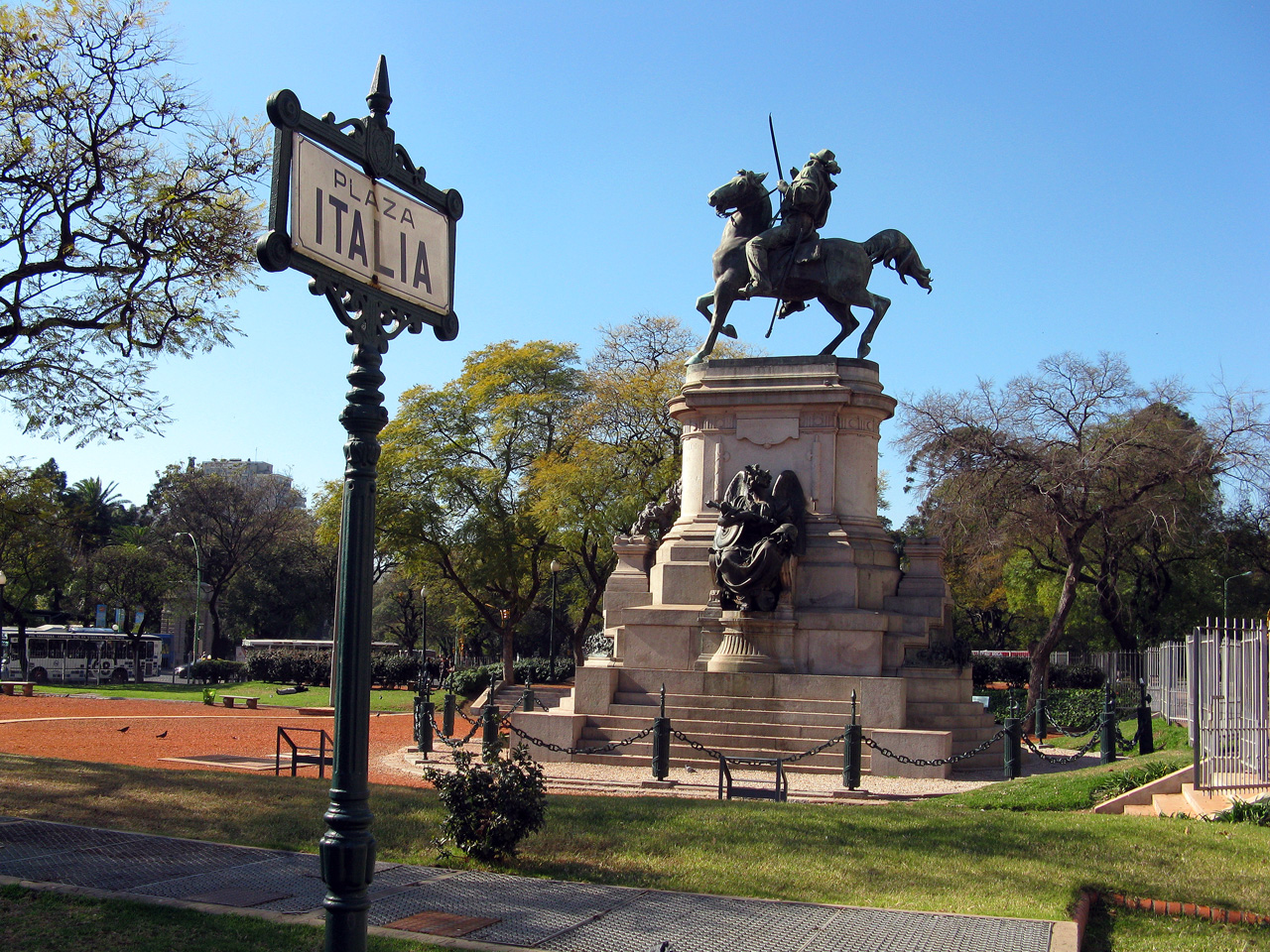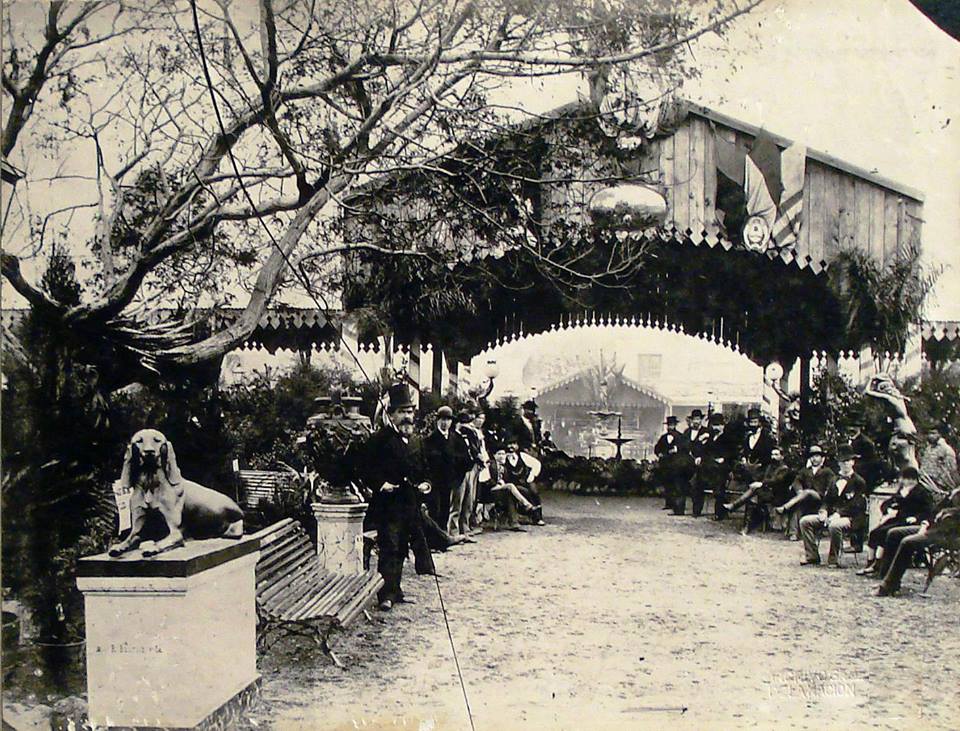|
Plaza Italia, Buenos Aires
Plaza Italia is a small park in the city of Buenos Aires in the barrio of Palermo, Buenos Aires, Palermo on the confluence of Santa Fe Avenue and Avenida Sarmiento. Next to the plaza are the main entrances to the Zoo and the Botanical Gardens, and the la Rural Expo Center. The area is very busy with traffic, as it is a public transportation hub for the city. In the center of the park there is an Monument to Giuseppe Garibaldi (Buenos Aires), equestrian statue to Giuseppe Garibaldi, which opened on 19 June 1904 in a ceremony attended by Presidents Julio Argentino Roca and Bartolomé Mitre. Under the park there is a metro station of the same name in the "D" line of the system. On the corner of the Plaza and the Exposition Center there is a Roman column, original from th ... [...More Info...] [...Related Items...] OR: [Wikipedia] [Google] [Baidu] |
Plaza Italia In Buenos Aires
A town square (or square, plaza, public square, city square, urban square, or ''piazza'') is an open public space, commonly found in the heart of a traditional town but not necessarily a true square, geometric square, used for community gatherings. Related concepts are the civic center, the market square and the village green. Most squares are hardscapes suitable for open market (place), markets, concerts, political rallies, and other events that require firm ground. Being centrally located, town squares are usually surrounded by small shops such as bakeries, meat markets, cheese stores, and clothing stores. At their center is often a water well, well, monument, statue or other feature. Those with fountains are sometimes called fountain squares. By country Australia The Adelaide city centre, city centre of Adelaide and the adjacent suburb of North Adelaide, in South Australia, were planned by Colonel William Light in 1837. The city streets were laid out in a grid plan, with t ... [...More Info...] [...Related Items...] OR: [Wikipedia] [Google] [Baidu] |
Bartolomé Mitre
Bartolomé Mitre Martínez (26 June 1821 – 19 January 1906) was an Argentine statesman, soldier and author. He was President of Argentina from 1862 to 1868 and the first president of unified Argentina. Mitre is known as the most versatile statesman, military man, politician, journalist, historian, writer and poet. He was a major figure in the history of Argentina during second half of the 19th century. He was the figure that best characterized liberalism in Argentina, but he was a moderate and flexible liberal, not dogmatic. Early life Mitre was born on 26 June 1821 in Buenos Aires. His father was of Greek descent and the family name was originally Mitropoulos.Gardner, James. "Buenos Aires: The Biography of a City", 110. (St Martin's Press, 2015, ). In 1831, his family settled in Uruguay. He became a soldier, and graduated in 1839 from the Military School of Montevideo, with the rank of second lieutenant of artillery. Also a journalist, his writings supported Fructuo ... [...More Info...] [...Related Items...] OR: [Wikipedia] [Google] [Baidu] |
La Rural
La Rural: Agricultural and Livestock Exhibition of Argentina ''La Exposición Rural'' (in English: The Rural Exhibition), is an annual agricultural and livestock show held in the Palermo section of Buenos Aires, Argentina. The event is organized by ''Sociedad Rural Argentina'' and both the exhibition and the society are known locally as La Rural. The exhibition has taken place in the society's Santa Fe Avenue exhibition centre and fairground, each year in July since its founding on July 10,1886. The Society was founded by Eduardo Olivera and José Martínez de Hoz with the motto 'To cultivate the soil is to serve the country', and was formerly known as 'El Solar de Palermo'. Built in the 1870s, the Society's showground features a Belle Epoque stadium and a modern exhibition hall. During the rest of the year, the exhibition hall is used for other events including trade shows. The ''Opera Pampa'' organizes shows in the stadium, showcasing the history of Argentina with zamba da ... [...More Info...] [...Related Items...] OR: [Wikipedia] [Google] [Baidu] |
Buenos Aires Botanical Garden
The Buenos Aires Botanical Garden (official name in Spanish: ''Jardín Botánico Carlos Thays de la Ciudad Autónoma de Buenos Aires'') is a botanical garden located in the Palermo neighborhood of Buenos Aires in Argentina. The garden is triangular in shape, and is bounded by Santa Fe Avenue, Las Heras Avenue and República Árabe Siria Street. The garden, which was declared a national monument in 1996, has a total area of , and holds approximately 5,500 species of plants, trees and shrubs, as well as a number of sculptures, monuments and five greenhouses. Origin Designed by French architect and landscape designer Carlos Thays, the garden was inaugurated on September 7, 1898. Thays and his family lived in an English style mansion, located within the gardens, between 1892 and 1898, when he served as director of parks and walks in the city. The mansion, built in 1881, is currently the main building of the complex. Collections The park has three distinct landscape gardenin ... [...More Info...] [...Related Items...] OR: [Wikipedia] [Google] [Baidu] |
Buenos Aires Zoo
The Buenos Aires Eco Park ( es, Ecoparque de Buenos Aires) is an park in the Palermo district of Buenos Aires, Argentina. The former zoo, opened in 1888, contained 89 species of mammals, 49 species of reptiles and 175 species of birds, with a total of over 2,500 animals. The institution's goals are to conserve species, produce research and to educate the public. In June 2016 the city formed a bias about the zoo's cruelty. They had to close the 140-year-old zoo and relocate most of the animals to nature reserves, including Temaikèn. The zoo property will be converted into an ''ecopark''. The zoo closed in 2016, reopening as an ecopark in 2018. Its more than 40 historic buildings (that had been declared historical heritage) were refurbished, including the arc at the main entrance, the parrots pavilion, the byzantine ruins, the ''Confitería del Aguila'', and the herons bridge, among others. [...More Info...] [...Related Items...] OR: [Wikipedia] [Google] [Baidu] |
Plaza Italia (Buenos Aires Metro)
Plaza Italia station is part of the line D of the Buenos Aires Underground. It is located at the intersection of Avenida Santa Fe and the roundabout surrounding Plaza Italia in Palermo. The station was opened on 23 February 1940 as part of the extension of Line D from Tribunales to Palermo. A short distance from the station are located the '' La Sociedad Rural Argentina'' (in English: The Argentine Rural Society), Buenos Aires Zoo and the Botanical Garden of Buenos Aires. In 1997 the station was declared a national historic monument. (Spanish) Retrieved 2010-11-09 Gallery Nearby *[...More Info...] [...Related Items...] OR: [Wikipedia] [Google] [Baidu] |
Electric Tram
A tram (called a streetcar or trolley in North America) is a rail vehicle that travels on tramway tracks on public urban streets; some include segments on segregated right-of-way. The tramlines or networks operated as public transport are called tramways or simply trams/streetcars. Many recently built tramways use the contemporary term light rail. The vehicles are called streetcars or trolleys (not to be confused with trolleybus) in North America and trams or tramcars elsewhere. The first two terms are often used interchangeably in the United States, with ''trolley'' being the preferred term in the eastern US and ''streetcar'' in the western US. ''Streetcar'' or ''tramway'' are preferred in Canada. In parts of the United States, internally powered buses made to resemble a streetcar are often referred to as "trolleys". To avoid further confusion with trolley buses, the American Public Transportation Association (APTA) refers to them as "trolley-replica buses". In the United ... [...More Info...] [...Related Items...] OR: [Wikipedia] [Google] [Baidu] |
Rome
, established_title = Founded , established_date = 753 BC , founder = King Romulus (legendary) , image_map = Map of comune of Rome (metropolitan city of Capital Rome, region Lazio, Italy).svg , map_caption = The territory of the ''comune'' (''Roma Capitale'', in red) inside the Metropolitan City of Rome (''Città Metropolitana di Roma'', in yellow). The white spot in the centre is Vatican City. , pushpin_map = Italy#Europe , pushpin_map_caption = Location within Italy##Location within Europe , pushpin_relief = yes , coordinates = , coor_pinpoint = , subdivision_type = Country , subdivision_name = Italy , subdivision_type2 = Region , subdivision_name2 = Lazio , subdivision_type3 = Metropolitan city , subdivision_name3 = Rome Capital , government_footnotes= , government_type = Strong Mayor–Council , leader_title2 = Legislature , leader_name2 = Capitoline Assemb ... [...More Info...] [...Related Items...] OR: [Wikipedia] [Google] [Baidu] |
Roman Forum
The Roman Forum, also known by its Latin name Forum Romanum ( it, Foro Romano), is a rectangular forum (plaza) surrounded by the ruins of several important ancient government buildings at the center of the city of Rome. Citizens of the ancient city referred to this space, originally a marketplace, as the ', or simply the '. For centuries the Forum was the center of day-to-day life in Rome: the site of triumphal processions and elections; the venue for public speeches, criminal trials, and gladiatorial matches; and the nucleus of commercial affairs. Here statues and monuments commemorated the city's great men. The teeming heart of ancient Rome, it has been called the most celebrated meeting place in the world, and in all history. Located in the small valley between the Palatine and Capitoline Hills, the Forum today is a sprawling ruin of architectural fragments and intermittent archaeological excavations attracting 4.5 million or more sightseers yearly. Many of the olde ... [...More Info...] [...Related Items...] OR: [Wikipedia] [Google] [Baidu] |
Julio Argentino Roca
Alejo Julio Argentino Roca Paz (July 17, 1843 – October 19, 1914) was an army general and statesman who served as President of Argentina from 1880 to 1886 and from 1898 to 1904. Roca is the most important representative of the Generation of '80 and is known for directing the Conquest of the Desert, a series of military campaigns against the indigenous peoples of Patagonia sometimes considered a genocide. During his two terms as president, many important changes occurred, particularly major infrastructure projects of railroads and port facilities; increased foreign investment, along with immigration from Europe; large-scale immigration from southern Europe; expansion of the agricultural and pastoral sectors of the economy; and laicizing legislation strengthening state power. Roca's main foreign policy concern was to set the limits with Chile, which had never been determined with precision. In 1881 Argentina gained territory by treaty with Chile. Upbringing and early ... [...More Info...] [...Related Items...] OR: [Wikipedia] [Google] [Baidu] |
Plaza Italia, Palermo
A town square (or square, plaza, public square, city square, urban square, or ''piazza'') is an open public space, commonly found in the heart of a traditional town but not necessarily a true geometric square, used for community gatherings. Related concepts are the civic center, the market square and the village green. Most squares are hardscapes suitable for open markets, concerts, political rallies, and other events that require firm ground. Being centrally located, town squares are usually surrounded by small shops such as bakeries, meat markets, cheese stores, and clothing stores. At their center is often a well, monument, statue or other feature. Those with fountains are sometimes called fountain squares. By country Australia The city centre of Adelaide and the adjacent suburb of North Adelaide, in South Australia, were planned by Colonel William Light in 1837. The city streets were laid out in a grid plan, with the city centre including a central public square, Victo ... [...More Info...] [...Related Items...] OR: [Wikipedia] [Google] [Baidu] |







